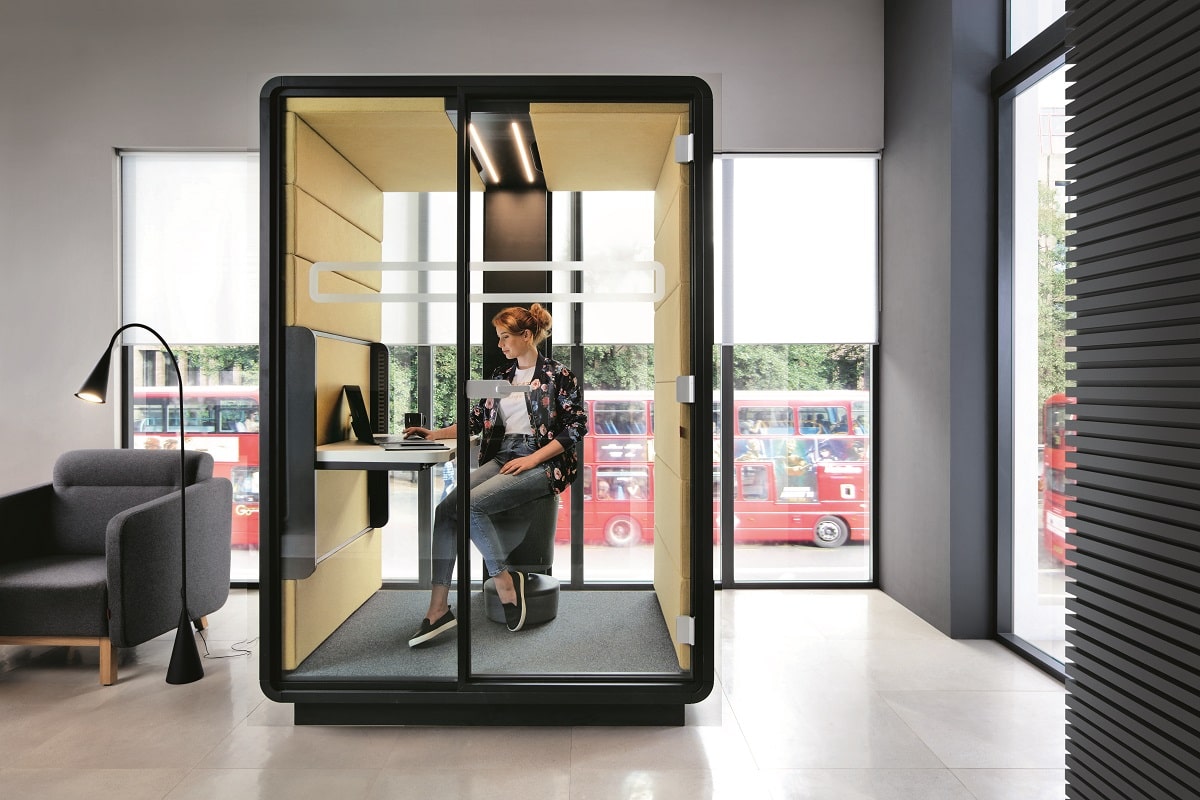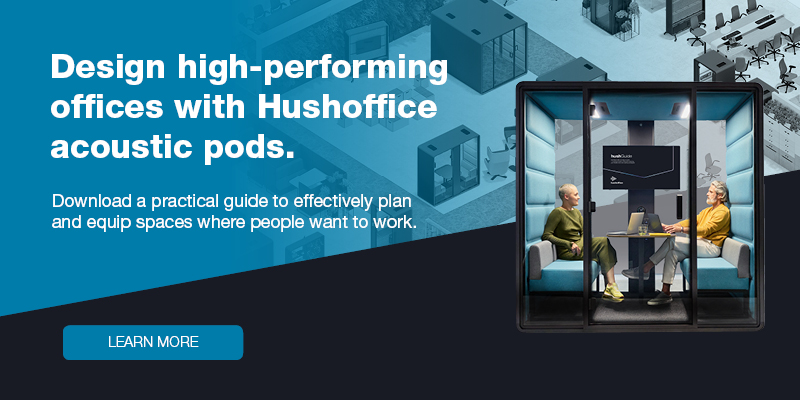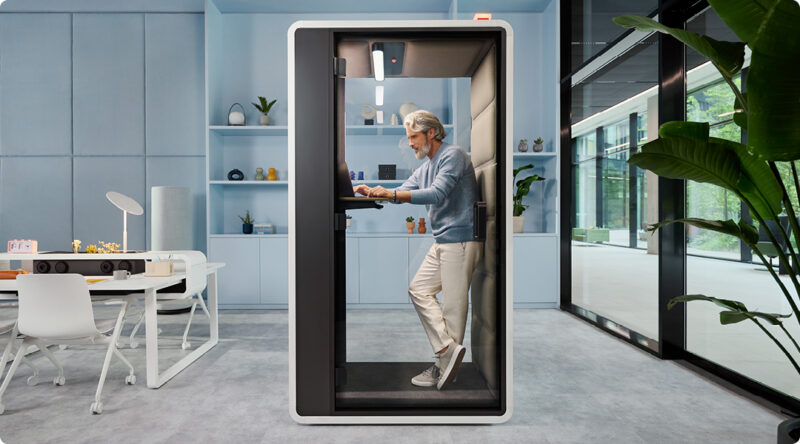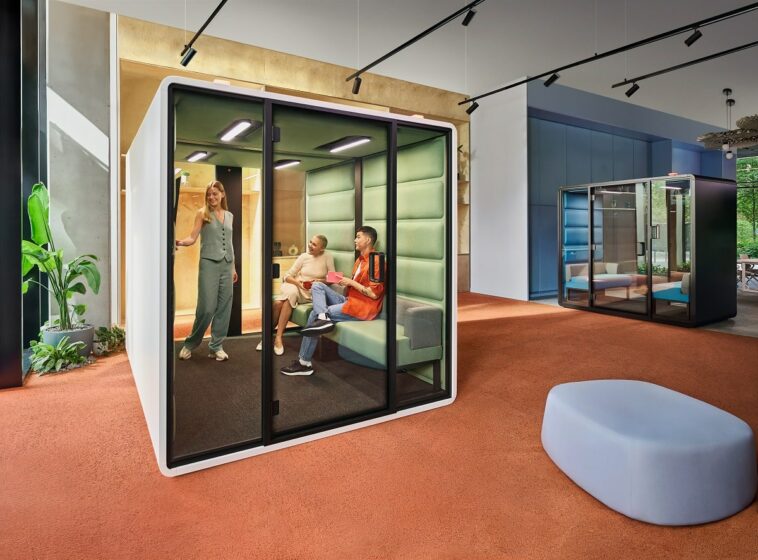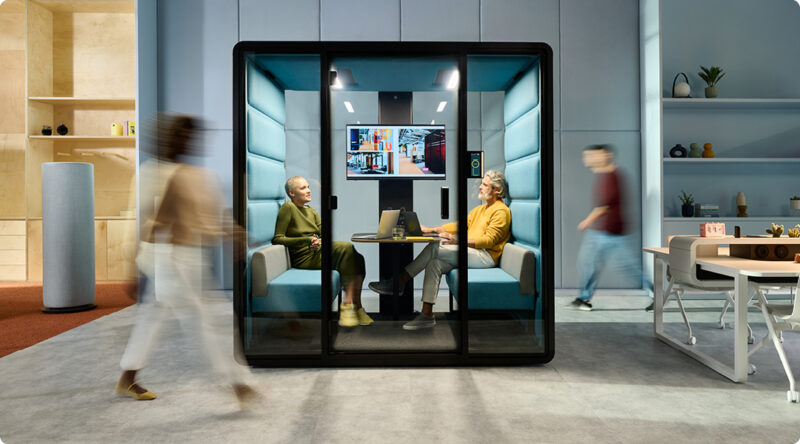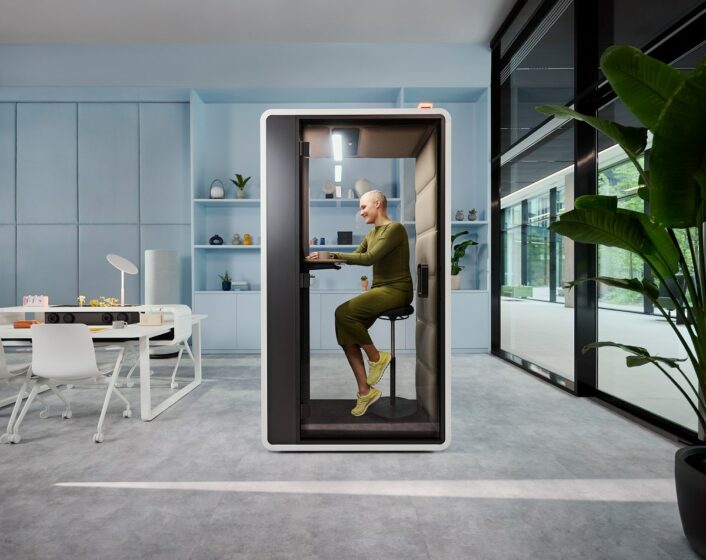Office design for neurodiverse workforce
- Posted on: 11 February 2022
- By: Hushoffice Team
Employee health is the current priority. To bolster it, the office design must accommodate neurodiversity. It must support each employee’s distinct way of thinking. Whether you’re planning a new zone or overhauling an existing one, the following insights will help you make it inclusive. Only then will a neurodiverse workforce flourish.
The neurodiverse office design – key takeaways:
Neurodiversity is the natural variation in human neurocognition, person to person. It all hinges on sensory integration — how we process multiple sensory inputs. While neurotypical people have typical responses to sensory inputs, neurodivergent people do not.
Neuroprocessing is done by the five senses, so accommodating neurodivergence is simply considering the office space through the senses.
Designing with neurodiversity top of mind is designing in an inclusive way. Also called inclusive or universal design.
Office design that factors neurodiversity benefits everyone. Consider acoustic work pods, which give both sound-sensitive neurodivergent and average neurotypical employees more sonic ambiance.
Focus on seven foundational aspects as you retrofit the office for a neurodiverse workforce: zoning (dividing space), wayfinding, movement, acoustics, lighting, air quality, and visual privacy.
What is neurodiversity?
Neurodiversity is the natural variation in human neurocognition, person to person. In simpler terms: we all think in different ways. We all process information, or sensory input, differently. This is because our brains are unique. Several factors also influence its neurocognition, from personality to cultural upbringing to age.
It all hinges on sensory integration — how we process multiple sensory inputs.
Sensory integration is the ability to process more than one stimulus or sensory input at a time. The keyword in that sentence is “sensory.” Neuroprocessing is done by the five senses: sight, hearing, smell, taste, and touch. Have you ever been walking somewhere new while talking? You tried to find your way and hold an engaged conversation at the same time. Most likely, you had to stop walking or stop talking to get oriented. This is sensory integration at work — human beings can process only so many inputs at once.
Neurodivergent office design is a matter of considering the workplace through all 5 senses.
When we design spaces, we need to think in a multi-sensory way. Spaces often get designed for function and looks. But we need to remember our ears and eyes are also processing the office. All of our sensory experiences factor into our response to the space, positive or negative
– highlights Mateusz Barczyk, Senior Brand Manager, Hushoffice.
Every employee has a unique sensory experience of their office per their neurocognition. We all see color, hear noise, and interpret space differently per our brain’s wiring. Designing for neurodiversity is, therefore, all about catering for neurological differences, using the five senses as guides.
While neurotypical people have typical responses to sensory inputs, neurodivergent people do not.
This is because of impaired sensory integration. Neurodivergent people often struggle to process multiple simultaneous inputs. Multiple inputs can be distracting for the neurodivergent, if not upsetting. Sensory overload results in some cases.
It is estimated 15-20% of people are neurodivergent.
Cognitive disabilities that make a person neurodivergent include ADHD, autism, dyslexia, dyspraxia, dyscalculia, Tourette syndrome, developmental delay, Asperger’s Syndrome, and OCD.
An ADHD employee will likely be more bothered by office activity than a neurotypical employee.
People with autism are often acutely sensitive to smells and textures. People with dyslexia sometimes struggle to make out speech in a noisy environment. People with dyspraxia may be extremely sensitive to light in some cases. People with OCD need order and cleanliness to be at ease. All of these sensory aspects play out organically on an open-plan layout. And because 15% of the workforce is neurodivergent, it’s pertinent that we perfect these sensory aspects, making the office more inclusive.
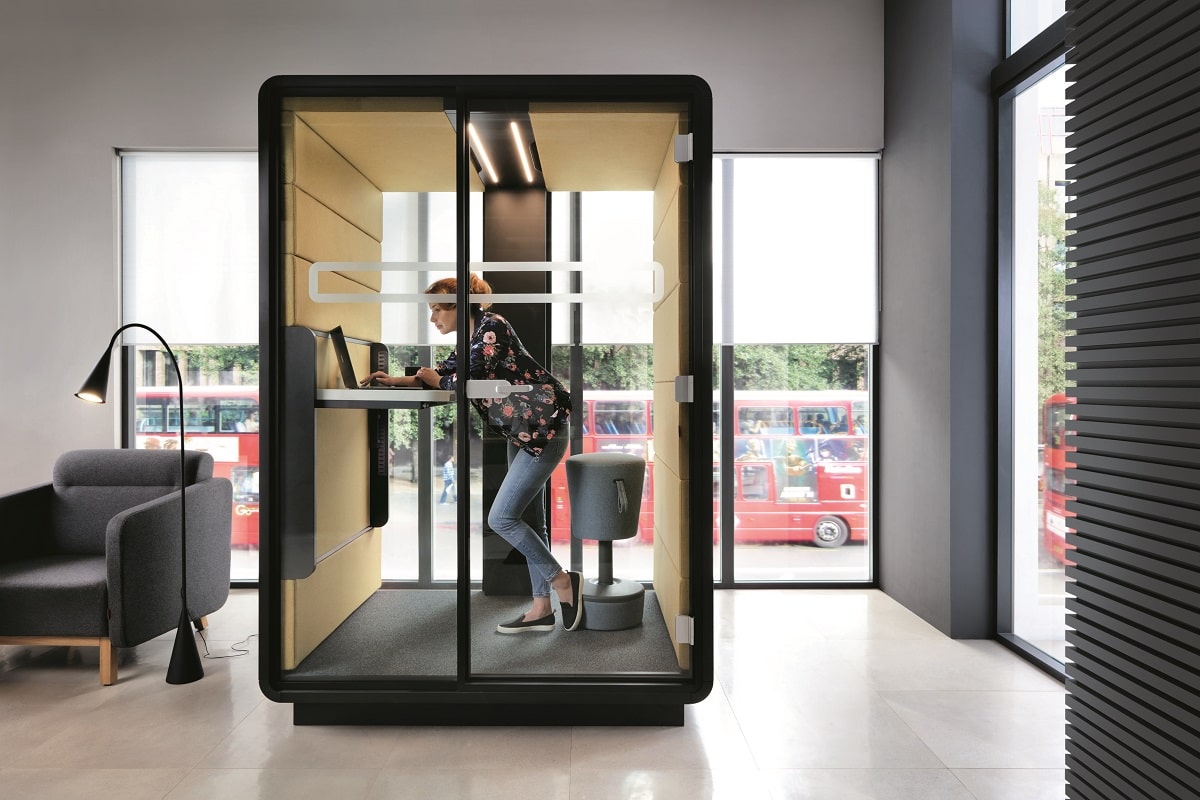
All five senses can be affected in an individual with impaired sensory integration.
The more senses that are impaired, the more difficult it is for this person to function in a space that’s dynamic or full of fluctuating sensory inputs. Say, a busy open-plan office.
Neurological functioning, productivity, and well-being are all closely linked.
It’s important to understand how employees process sensory stimuli in the workplace because our office, like any environment, is made of sensory stimuli. In other words, we experience the office through our senses. So even the slightest design choices like what color or pattern to use on the flooring affect our senses, positively, neutrally, or negatively. And as a result, our ability to focus, think, and feel well are all affected.
What is it like to be neurodivergent in an open-plan office?
For perspective, check out the virtual-reality immersive video from BBC’s CAPE project. It gives you an immersive experience: what the typical office is like for a person with neurodivergent traits. The video powerfully illuminates the importance of designing workspaces that are inclusive.
Designing with all five senses in mind creates a better office experience for everyone. It’s the path to making the office a cherished destination, not just a building people work in. When an enjoyable experience awaits employees, employees look forward to their days on-site. Not only that, but they’re more productive on-site. Here we see how mastering sensory inputs to accommodate neurodivergence and crafting a better office for the entire workforce are really the same thing
– lends Mateusz Barczyk, Senior Brand Manager, Hushoffice.
Does your office space cater for neurodiversity?
Look to BBC CAPE project’s Environment Checklist. Completing it will tell you the cognitive accessibility of the space in question. You’ll gauge visual, auditory, olfactory, and tactile elements.
Workplace design with neurodiversity in mind is designing in an inclusive way.
When you design for neurodiversity, you accommodate a spectrum of preferences — preferences from neurodivergent and neurotypical employees alike. This is why neurodiversity in the workplace is also called inclusive or universal design — it benefits everyone. Inclusive spaces are effective because they cater for the entire array of employee needs.
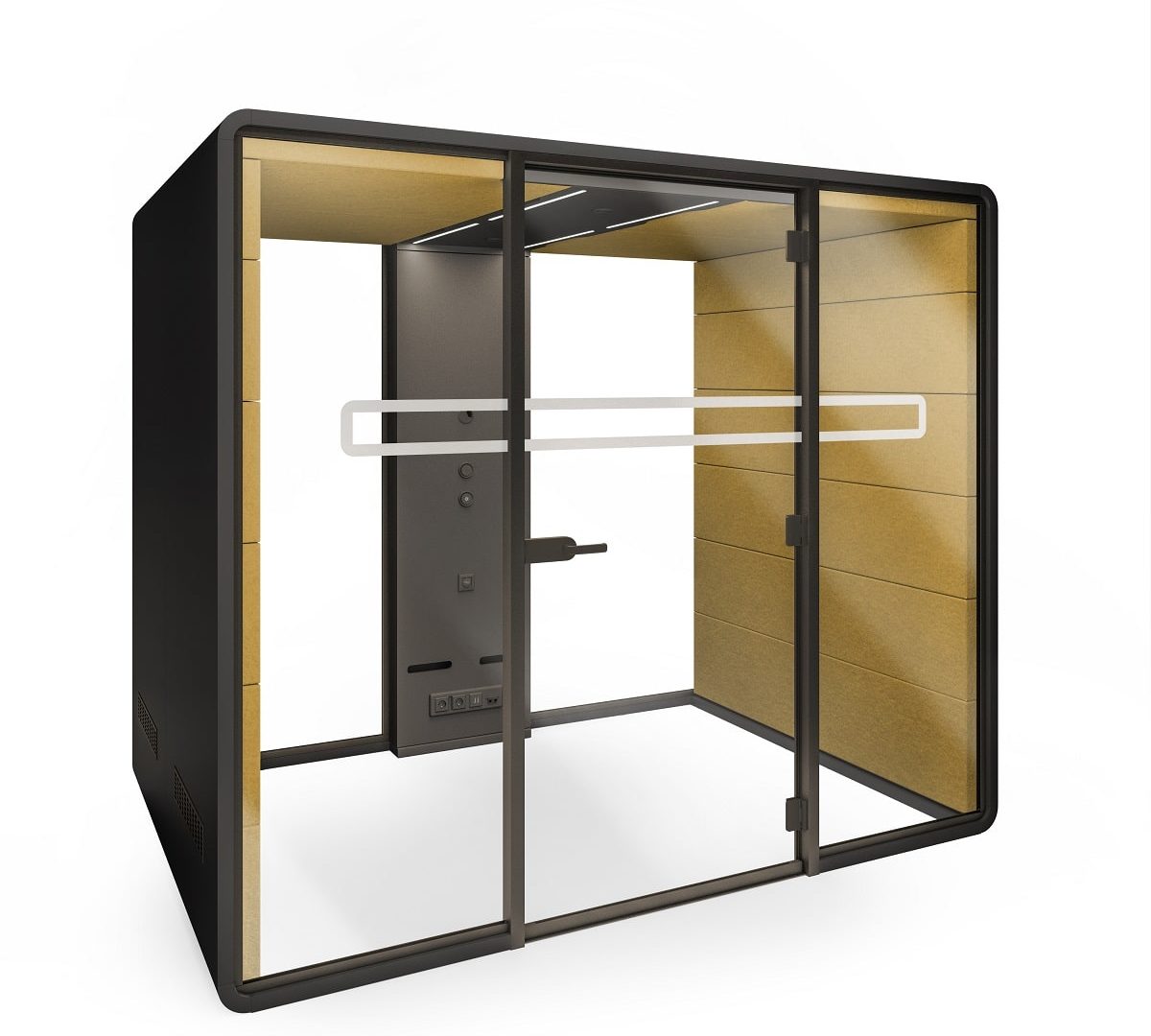
Office design that factors neurodiversity benefits everyone.
Let’s take an example. Neurodivergent people sometimes have difficulty managing distractions. So an office that’s distracting will disproportionately upset neurodivergent employees. But in fact, distractions are agitating on some level for employees of every kind. By eliminating distractions, we do more than remove a severe obstacle to the neurodivergent employee’s success. We make the floor plan more peaceful and productive for everyone.
Consider acoustic work pods, which give employees of all kinds sonic ambiance.
A specific example. Acoustics. Reducing office noise and improving the space’s “sound” using acoustic pods benefits those sensitive to noise. But it also benefits those who are only occasionally irritated or diverted by collaborative clatter and other typical office rackets.

If you’ve wondered what it’s actually like in an acoustic work pod, here’s a read for you: Private pods. What does privacy actually feel like in an office pod?
Neurodiversity is a competitive advantage.
Diversity is a special edge once wielded intelligently. Certain neurological disorders come with tremendous talents that neurotypical people don’t naturally possess. For many neurodivergent people, their “disability” is actually their superpower.
Neurodiverse thinkers are often exceptionally innovative and canny problem-solvers.
They often have a knack for niche skills like pattern recognition, design thinking, and coding. So a more diverse workforce boasts more creative and intellectual capacity. A diverse workforce is also able to connect with diverse consumers.
It’s about giving people choice and letting the senses guide.
As emphasized, we process our environment through our senses. So we want to offer variety on the sensory plane. We want to provide options. An array of soundscapes, thermal environments, light qualities, and the like. With options like this, employees are free to work in the zones that support their preferences and needs. In short, they have autonomy over their space.
We wrote about how this kind of command helps prevent burnout: Is the open space a source of office burnout?
Focus on seven foundational aspects as you retrofit the office for a neurodiverse workforce.
Improving these seven aspects will lead to a more inclusive space. Zoning (dividing space), wayfinding, movement, acoustics, lighting, air quality, and visual privacy.
1. Zone the office space using dividers and office privacy pods
The idea is to create a rich landscape, so employees can find the zone where they’re most comfortable, most focused. And we do this by thinking in a sensory fashion. All of the senses… what we see, hear, taste, feel, and smell. We’re crafting a high-quality, enjoyable environment by letting the senses lead
– offers Mateusz Barczyk, Senior Brand Manager, Hushoffice.
This will allow you to create different environments with different degrees and characters of stimulation.
Zoning prevents sensory overload.
Quiet zones should be limited in stimuli. Active zones should be high-energy. Offering hands-on tactile elements to help kinesthetic learners focus is a good idea too.
Some zones should be open and social, while some should be closed and private.
And each zone ideally offers a distinct sensory landscape. Distinct in terms of light, sound, and visuals. So at a high level, there’s variety, and the employee gets to choose the right zone for the moment.

Is burnout an issue? Here’s a recommended read: 5 ways to prevent open office burnout.
Quiet zones and office quiet pods should provide a sensory escape.
Some people dislike solitude. Some need to retreat from stimuli in the open space office at frequent intervals. Some just perform best in sparse environments. Quiet zones or acoustic work pods like the Hushoffice collection help all types.
Minimal and restorative.
Quiet zones should be peaceful places to disconnect, relax, and recharge. A little sensory break. This is critical for those who are deeply affected by their surroundings. Offering privacy and seclusion through the use of space dividers and private office pods helps everyone. Those who get social anxiety, for instance, can enjoy short resets in a wraparound booth or private pod. You can make the office a place all perform at their best.
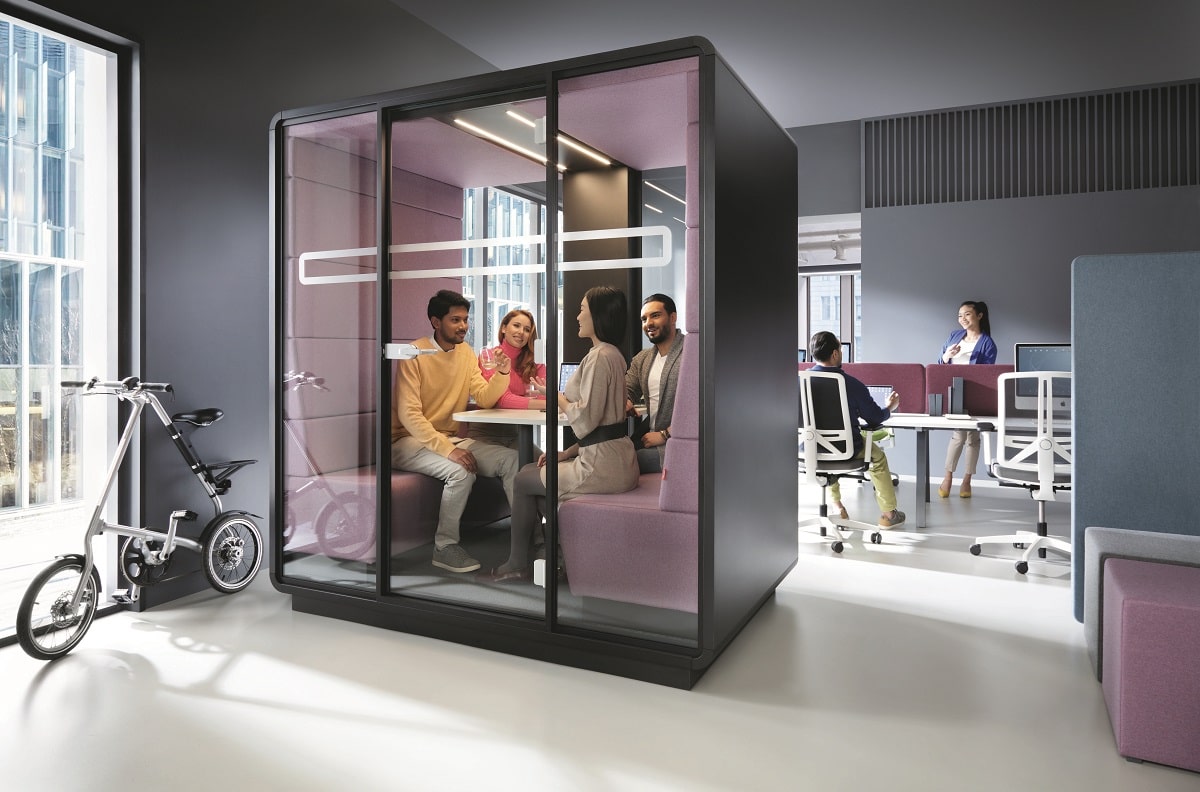
2. Improve wayfinding
Security and a sense of control are vital to a neurodivergent person’s well-being. Not to mention, their capacity to concentrate. Help people find their way and feel at home. Aim for spaces that are engaging and memorable.
Use repeated design features to create a reassuring sense of order and familiarity.
Color can be useful here. Strong focal points like artwork can help employees orient themselves, too. Clear, consistent signage is crucial.
Display pertinent information somewhere it can be easily seen.
Each zone or space should be intuitive and easy to navigate. As a rule, avoid patterned flooring, which can be unsettling to walk on, causing anxiety.
3. Give employees opportunities for movement
For fidgety employees, this one’s big. Catering for kinesthetic needs is part and parcel of universal design. Movement helps those with attention disorders to focus. It allows them to release frenetic energy and thus ease their mind. Through movement, neurodivergent employees can stay more locked in on the activity.
Movement can take many forms in office design.
Height-adjustable desks, for instance, can be great for employees who need to stay in motion for any given reason. They’re a terrific asset for those with back pain, especially. Movement keeps such aches and pains at bay. Sit-stand desks can also boost productivity. Some people find their creative juices flow more freely when standing than when sitting, for instance.
Movement is a strong foundation for good ergonomics.
The human body was designed for continual motion, not for sitting at a desk all day. It’s good for the mind, too, stimulating different brain parts, supporting different types of tasks. Here again, we see how accommodating the neurodivergent benefits everyone variously. And how the principles of universal or inclusive design dovetail perfectly with ergonomics and other wellness-focused design philosophies.
A few more pointers to consider:
Ensure active zones foster movement — consider active furniture like rocking chairs, active stools, and mobile whiteboards
Offer employees tools like stress balls and fidget spinners to help calm an overactive mind
Encourage employees to break between focused work sessions
Invest in ergonomic furniture that supports movement at the desk like footrests, active chairs, and sit-stand desks
Get an ergonomics assessment
Gift employees with dual monitors (this assists organization and information retention for those who struggle with it — it also supports eye health, good posture, and productivity for employees of every type)
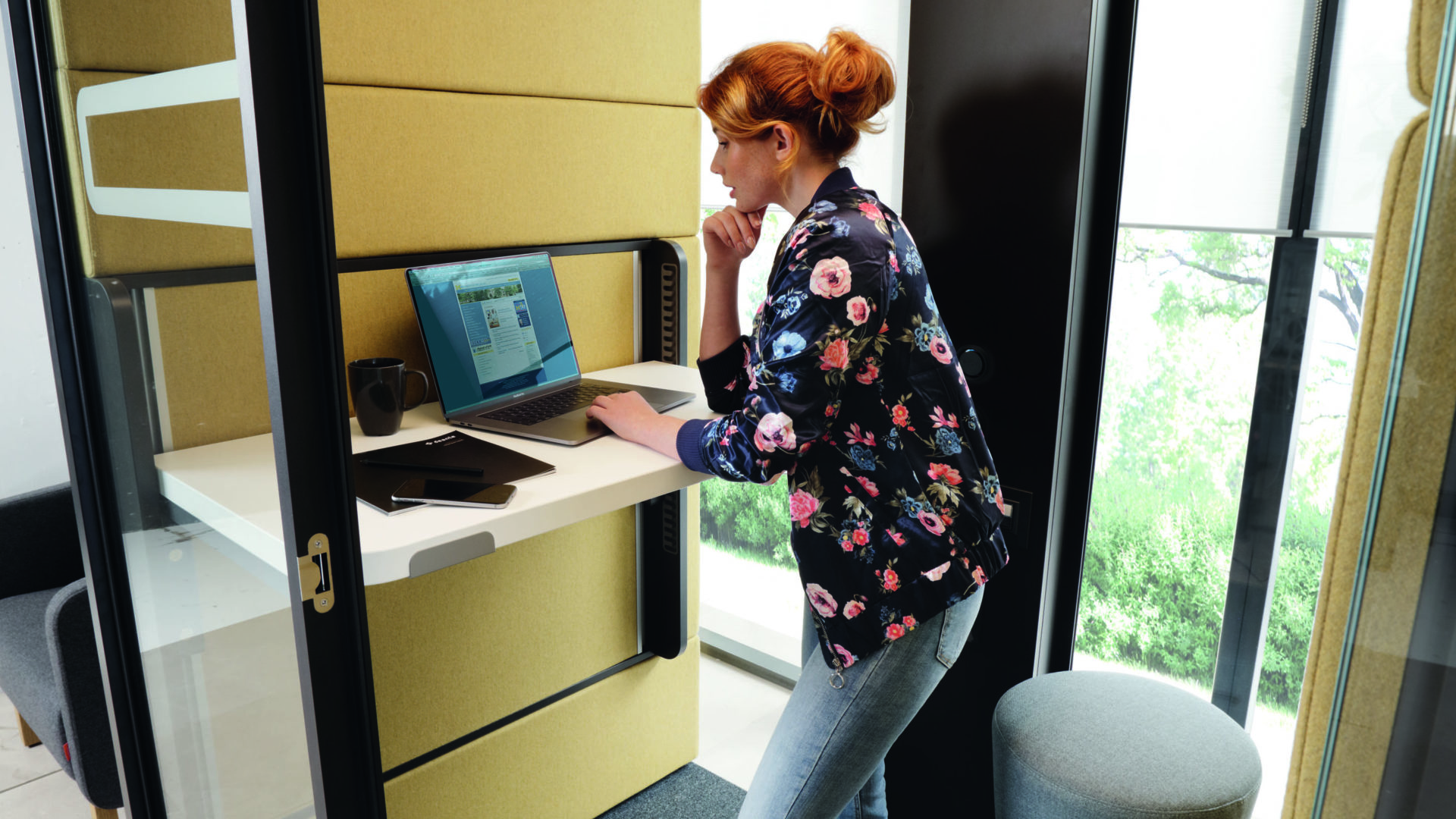
Simple tools can bring movement to the desk.
Sometimes called fidget furniture. Footrests for standing desk setups can be wonderful, allowing employees to prop one foot at a time, keeping the body in motion. Rocking or traditional footrests for sitting desks can be wonderful, too, keeping the legs in motion. This motion breaks up the sedentary nature of desk work. Standing desks, height-adjustable desks, desktop converters, and active chairs are also worth looking into.
4. Create a variety of acoustic soundscapes using treatments and portable office pods
This allows employees to pick the soundscape or pod that supports their needs. If office soundproofing overwhelms you, check out our recent blog as a starting point: The quick, comprehensive guide to office noise.
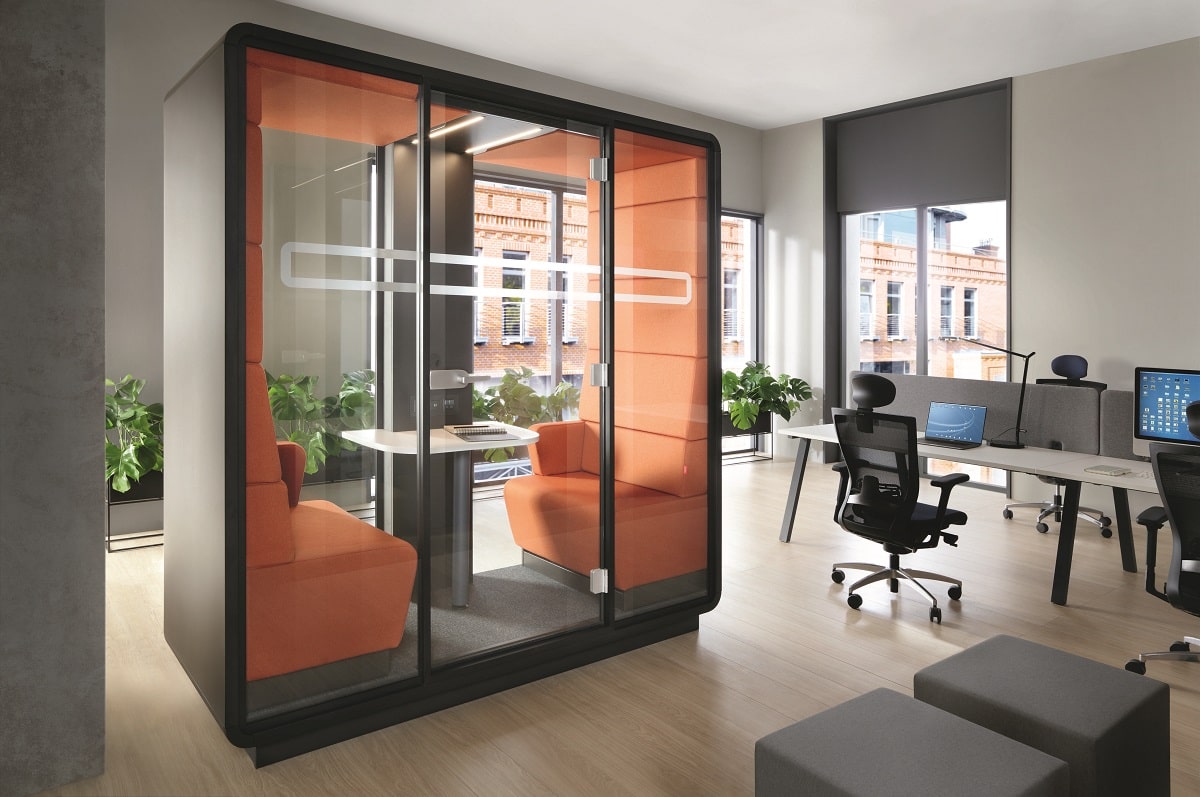
Neuro-inclusive office design – heed the following advice as well:
Position workspaces in low-traffic areas
- Offer quiet rooms or private work pods for intense concentration
Use dividers to block and reduce unwanted noise
Encourage employees to use noise-canceling headphones if desired
Finish each office zone with acoustic dampening materials like baffles, panels, and screens to create a soothing soundscape
Consider investing in a white noise machine for the open office if your space is awkwardly quiet
Envision an office with multiple soundscapes for multiple tasks and tastes.
The fact is different soundscapes support different tasks. For example, quieter acoustics are generally more conducive to deep focus. Quiet like the library. Livelier acoustics are generally more conducive to productivity. Lively like a bustling coffee shop.
“Generally” being the operative word here because sound is like music. We all have different tastes, regardless of neurocognition. What supports focus for one employee destroys it for another. Hence, tried-and-true variety is the way. You want to offer employees a variety of acoustic zones — each one falling somewhere special on the quiet-bustling sound spectrum.
An acoustically diverse workplace is a more productive workplace.
The beauty of creating such an office landscape with multiple sonic zones is just that: different acoustics cater to different tasks. 70dB is the sweet spot for creativity, while 40 dB is the sweet spot for focus (hence private work pods like hushWork.sit&stand deliver 40dB of sound). In summary, a rich landscape of sound supports a broader scope of tasks.
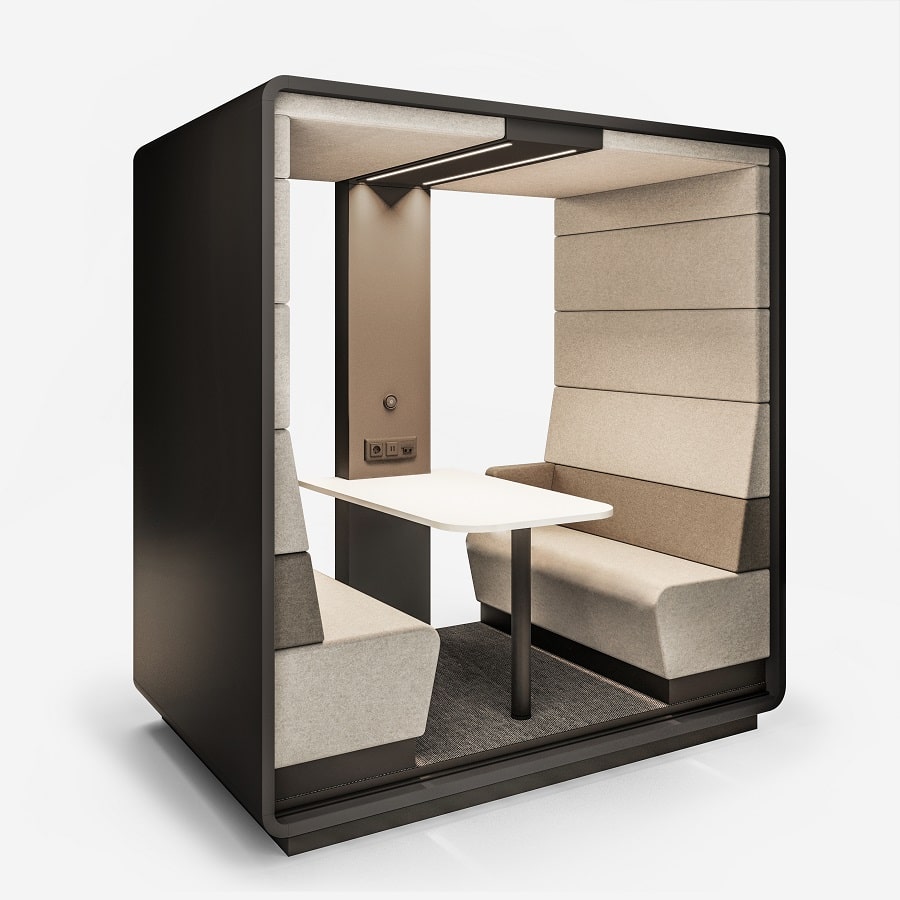
5. Enhance lighting, making it adjustable where possible
Try to vary lighting levels throughout the office space. Bright lighting is shown to intensify emotions, both positive and negative. Dimmer lighting is more conducive to decision-making. So providing both bright and dim light levels throughout the office is scientifically keen.
Some people prefer dimmer lighting as it makes them feel protected or cocooned.
Consider surveying your workforce to gauge preferences.
The following best practices are applicable, too:
Ensure workspaces aren’t lit too brightly
Offer adjustable lighting where possible
Minimize glare through glare-reducing film
Let natural light flood select spots in the office
Avoid fluorescent lighting and low-quality LEDs

6. Improve air quality and thermal comfort
Thermal comfort is a foundational aspect of ergonomics. In fact, greener office environments boast higher cognitive functioning from their employees. Greener meaning what exactly? Natural light, fresh, well-ventilated air, and luscious green plants. Research has even shown that such a basic measure as doubling the ventilation rate in the typical office (which costs < $40 per employee per year) yields an 8% improvement in performance. This translates into a $6,500 increase in productivity per year.

Let the following pointers help you improve your office’s air quality and thermal comfort:
Regularly service the HVAC
Ensure optimal humidity and airflow through the space
Consider investing in desktop air purifiers, fans, and heaters
Bring in more plants — they clean and freshen the air, help achieve target humidity levels, and revitalize morale
Manage smells from cleaning products and food

7. Reduce visual distractions
Reducing visual distractions is major. It protects focus. It also enhances visual privacy. The result is a kind of visual ambiance — the employee is at home in their zone, able to tune out their surroundings. Visual ambiance is essential for employees that are easily distracted. And at the same time, it’s conducive to better work from employees of all types.
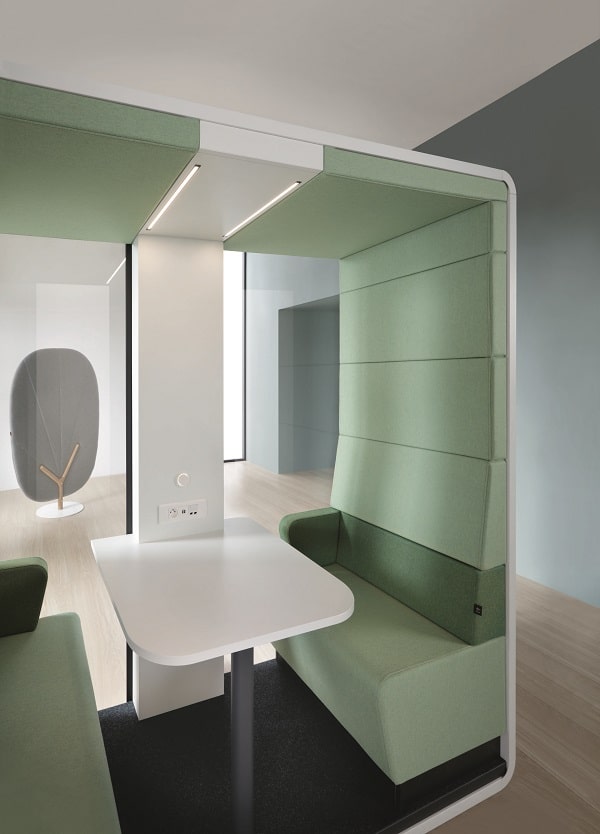
Consider the following solid tips as well:
Vary non-stimulating color palettes with stimulating color palettes throughout the space
Avoid busy patterns and color choices at workstations
Replace flickering fluorescent lights
Reduce visual clutter, provide storage space, and promote a clean desk policy
Eliminate or cover devices and equipment that flash
Allow employees to sit where they want, away from doors, windows, and displays if preferred
Purchase privacy filters for devices
Implement natural materials like wood for a visually lulling effect
Improve visual privacy using mobile partitions and desktop dividers
Encourage employees to adjust their screen brightness to a comfortable level
- Surface glass panels with films, stickers, and graphics for additional privacy
Invest in blue light blocking glasses
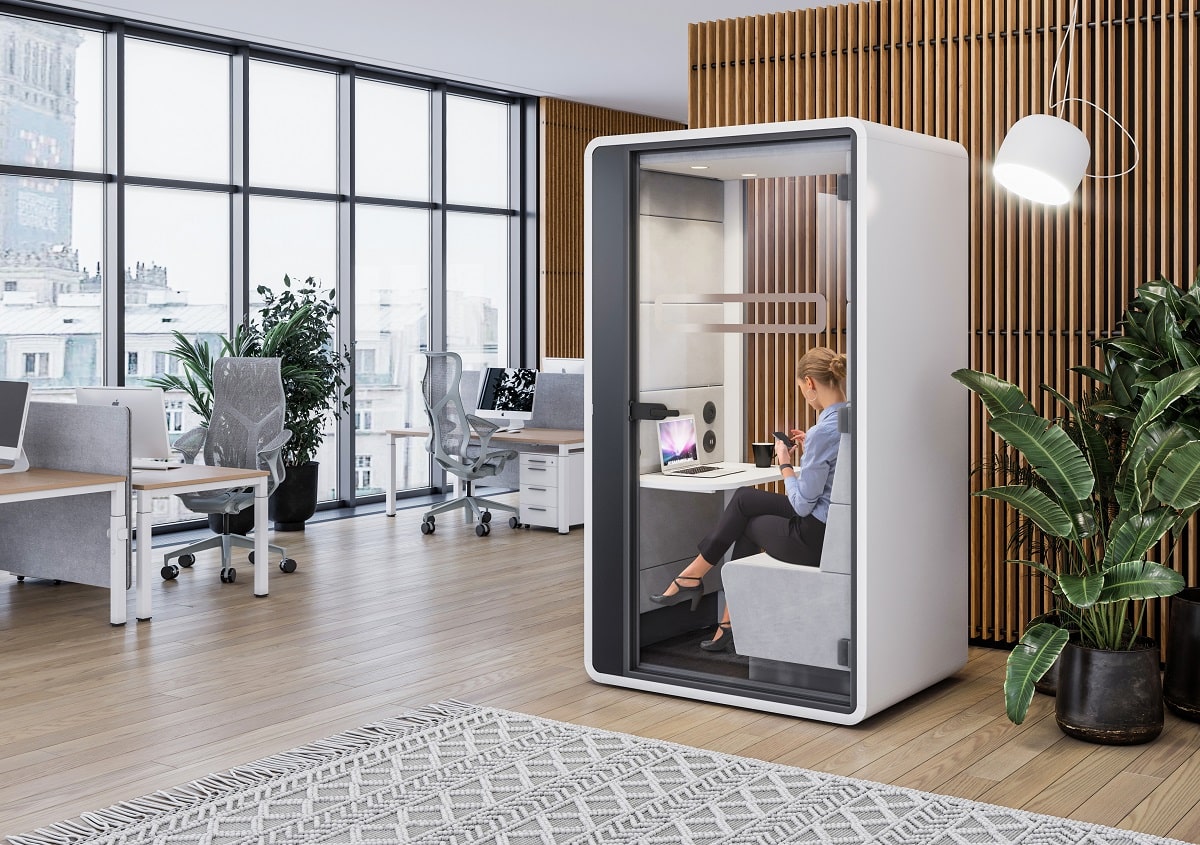
Neurodiversity is a gold mine of opportunity.
As indicated, the principles underpinning inclusive, universal design are very much in line with the principles of ergonomics, biophilia, and other health-centered approaches to office design. Eliminating harsh glare helps those super sensitive to light. But it also alleviates eyestrain across the board. And thus protects your team’s eyesight long-term. The list of such overlaps is encouragingly exhaustive.
This should inspire a solid resolve to design and retrofit for neurodivergent teammates. What we ultimately find is that accommodating neurodiversity in the office is more than plain good sense. It’s a gold mine of opportunity. In one fell swoop, you empower the potential of the neurodivergent and the neurotypical alike.
Neurodiverse office design – key takeaways:
Neurodiversity is the natural variation in human neurocognition, person to person. It all hinges on sensory integration — how we process multiple sensory inputs. While neurotypical people have typical responses to sensory inputs, neurodivergent people do not.
Neuroprocessing is done by the five senses, so accommodating neurodivergence is simply considering the office space through the senses.
Designing with neurodiversity top of mind is designing in an inclusive way. Also called inclusive or universal design.
Office design that factors neurodiversity benefits everyone. Consider acoustic work pods, which give both sound-sensitive neurodivergent and average neurotypical employees more sonic ambiance.
Focus on seven foundational aspects as you retrofit the office for a neurodiverse workforce: zoning (dividing space), wayfinding, movement, acoustics, lighting, air quality, and visual privacy.
Office design with neurodiversity in mind – FAQs
What is a neurodiverse person?
A neurodivergent person thinks differently or processes information and sensory input differently than the average person. Examples of neurodiverse conditions include ADHD, Autism, Dyspraxia, Dyslexia, Dyscalculia, Dysgraphia, Tourette’s syndrome, and OCD.
How do you accommodate neurodiversity in the workplace?
You accommodate neurodiversity in the workplace by giving employees choice, first. Second, fine-tune the workplace’s sensory experience. Humans process their office through the five senses. And neurodivergent people are often particularly sensitive to sensory inputs. By improving the office’s sensory experience — lighting, ventilation, air quality, acoustics, visual activity — you make the office work better for both neurodivergent and neurotypical employees. Both are affected by stimuli. Where possible, give employees the ability to adjust these factors — lighting, ventilation, air quality, etc. This allows employees to achieve the most conducive workspaces per their unique wiring and preferences. Acoustic work pods like the Hushoffice collection are an apt solution for neurodivergent employees because they offer a peaceful, quiet, cocooned refuge from the open floor, which is often overstimulating.
What are the best solutions to accommodate neurodiversity in the office design?
The best workplace solutions catering to neurodiversity are products and furniture that improve the sensory experience. Acoustic space dividers, desktop partitions, sound dampening treatments, private work pods like the hushPhone acoustic call booth or the hushMeet acoustic meeting pods, white noise machines for office privacy, wayfinding and signage, ergonomic furniture, dual-monitor setups, noise-canceling headphones, glare-reducing screen films, high-quality ambient lighting, desktop air purifiers/fans/heaters, and device privacy filters are some of the most effective solutions to consider.
